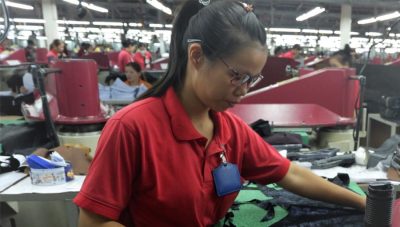Join a powerful, unprecedented alliance for better eye health for all.
Join IAPB-
Choose an alternate language here
What happens when you empower female factory workers to take charge of their own eye health? What if you tweak their work environment to encourage positive health behaviours? What if you educate factory staff and management to build a culture that promotes eye health?
Fred Hollows Foundation investigated these questions in their project, “Improving Vision to Empower Female Factory Workers”, which ran from July 2017 to December 2019. Funded by the Standard Chartered Bank, the project introduced eye health interventions in two factories in Quang Nam and Da Nang in Viet Nam. The project made a direct impact on more than 15,000 factory workers – 13,659 of whom are women.
By investing in their eye health, we have seen remarkable results in the lives of female factory workers. Comparing data gathered from the beginning and end of the project, the following improvements were observed:
All these good results were made possible through the combined efforts of factory workers, leaders, and health staff. By focusing not only on the factory workers, but also on their work environment and culture, the project was able to achieve long-lasting results.

Achieving these great results, the Fred Hollows Foundation in Viet Nam learned the following lessons:
Identifying a suitable key partner at the initial project development stage is important: in this case the provincial Trade Union was the most suitable legal agency as they represent workers and labourers in the whole province and they have a strong relationship with factories located in the province.
Close partner support is required: as partners are new to eye care, The Fred Hollows Foundation’s assistance has been the driving factor towards ensuring that partners optimally implement the project through provision of expertise, guidance and close support.
Working around factory requirements helps with management buy-in: project activities should limit disruption to factories and must be consistent with factories’ existing business and security requirements such as factory visits, picture taking of workers with factory products or eye care service convenience to workers to ensure full project support from management boards.
Factory medical staff, human resource personnel and project partners are critical stakeholders: encourage enthusiasm, responsibility and project ownership from factory management personnel. They should be informed and oriented of project activities in advance and encouraged to take the lead on project implementation which bring benefits to their colleagues/workers and their factory.
It’s important to be flexible around unstable factory production: As factory production schedules can be unstable, depending on work flow, the project model should retain some flexibility to mitigate against the risk of changing circumstances in factories. It’s best not to plan too many project activities ahead in a particular factory without having a backup plan to reallocate the project activities to other factories as circumstances require.
As more women enter the workforce, prioritising eye health contributes not only to one’s well-being, but also to one’s productivity and overall satisfaction in the workplace – and by extension, in the families and communities where female workers belong.
Author: Phan Thi Trang, Project Manager, The Fred Hollows Foundation in Viet Nam